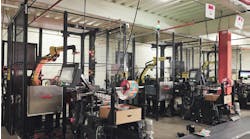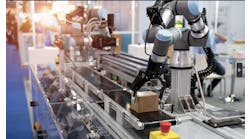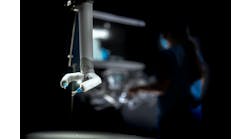Created in 1970, the purpose of the Occupational Safety and Health Administration (OSHA) is to help employers and employees to reduce job-related injuries, illnesses and deaths and to promote a safe and healthful working environment for the nation’s workforce.
With the end target being OSHA's stance on the new RIA robot safety technical specifications, Jim McManus, safety specialist, Region V Enforcement Programs, at OSHA provided an inspection snapshot at the 2016 National Robot Safety Conference in Cincinnati. McManus discussed how OSHA conducts an inspection and how OSHA views robot safety. In between those topics, he discussed OSHA's favorite topics—machine guarding and control of hazardous energy.
Robots are a relatively new industry for OSHA, and it doesn't actually have a standard on industrial robots. It's the government, so it takes eight to 10 years to create a standard or modify the rules. It literally takes an act of Congress to change anything at OSHA.
Despite that, McManus pointed out that it is every employer’s legal responsibility to recognize workplace hazards and to provide safe and healthful working conditions for their employees. It's also important for the employee to follow the rules of their employer, and the employer should have procedures in place to ensure that the employees are following the rules.
"There is a lot of talk about risk assessment," said McManus. "That's what I do. I evaluate conditions. Is there a hazard? Is there the proper exposure controls to keep the employee safe? If your company is in a high-risk industry, OSHA may visit. Inspection priorities include imminent danger, fatalities and catastrophes, complaints and referrals, programmed inspections and follow-up inspections."
OSHA doesn't know all
"Something to keep in mind, if a compliance officer knocks on your door, is that there are a lot of industries and machines out there," continued McManus. "In many cases, when we are talking about robotics or collaborative robots, consider that the compliance officer has probably never seen one before. You will probably have to walk them through some of the safeguarding methods you have in place. Although the expectation is that we are the expert on all equipment, the reality is that it is not possible. We will rely on the employer to walk us through the process."
The key U.S. safety standard for equipment is OSHA CFR Title 29 Part 1910 General Industry and, specifically, 1910.212—General requirements for all machines. The standard states in part that one or more methods of machine guarding shall be provided to protect the operator and other employees in the machine area from hazards. The guarding required must be provided by a device that does not allow reliance upon the skill or attentiveness of employees. It is intended to eliminate danger from unsafe operating procedures, poor training or employee inadvertence.
"Machine guarding is very performance-based,” said McManus. "There is a lot of interpretation on what is adequate and what is effective. Part of our job is to work with companies to make that determination."
There are four elements that must be present for OSHA to issue a citation. First, there must be a standard that applies or the general duty clause in Section 5(a)(1) of the Act. Secondly the standard must be violated. Thirdly, there must be employee exposure to the fourth element, the hazard.
What, no guard?
"There are so many different types of machines, so what does OSHA do when there are no specific standards," asked McManus? "Since 90% of machine guarding is addressed under 29 CFR 1910.212 General Machine Guarding, that is the standard used. OSHA states robots are machines and as such must be safeguarded in ways similar to those presented for any hazardous, remotely-controlled machine.”
If an OSHA compliance officer walks in and sees a robot operating without a guard, it is going to set off alarm bells, said McManus. "There is a robot, so there must be a cage or someone is going to get hurt, right?" he asked. "How do we address the safety of employees working around robots? The controls, mechanical, industrial and manufacturing engineers have the knowledge and experience and are helping to develop the robot standards, so that is what OSHA is going to do. It will use the new standards, the specifications and the engineer's experience. That's who has knowledge of the equipment, has knowledge of the hazards and knows how to address the hazards. We primarily lean on the ANSI standards."
There is also the ANSI/RIA R15.06—Industrial Robots and Robot Systems—Safety Requirements. "OSHA's view on robot safety is that if the employer is meeting the requirement of R15.06, then they would be doing everything we would expect them to do," said McManus. "If you are in compliance with this consensus standard, then you'll have no issues with OSHA."
RELATED: Robots allowed contact with humans under new collaborative specification
Consider all risks and standards
Several OSHA investigations have found that many robot accidents do not occur under normal operating conditions. Accidents occur during nonroutine operating conditions, such as programming, maintenance, testing, setup or adjustment. The proper selection of an effective robotic safety system must be based on the application of a particular robot and not just during normal production.
McManus suggests, if inspected, provide OSHA the risk assessments, job hazard analysis/job safety analysis, drawings and schematics, safety device specifics, minor servicing task list and justification, and lock-out-tag-out program and procedures. Additionally, the employer needs to know the system and know how to explain it to the OSHA compliance officers. The employer needs to clearly understand how the system functions and why it is safe. That's the standard and that's what is required.






